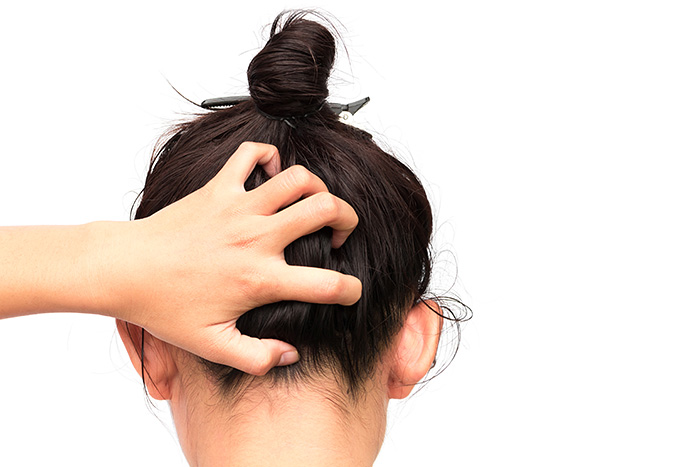What is dandruff?
We all know the embarrassing moment when people can see white flakes – dandruff on your shoulder. Dandruff is a chronic condition that is commonly marked by itching and an excessive flaking of the scalp. While it may not be contagious, it might cause someone to lose some self-esteem if someone is excessively scratching away!
The specific cause of dandruff is currently unclear, but common causes of dandruff include oily scalp, changes in weather and micro-organisms (such as bacteria/ fungi) that inhabits on the scalp. This results in the skin cells to regenerate faster than normal (2x as fast!) which results in the shedding of white patches (aka dandruff “flakes”) and in the inflammation of the scalp.
How common is dandruff?
It is estimated that 50% of general adult population is affected by it worldwide. Those about 20 years old are most affected, while it is less common in those over 50 years old.
Who is likely to develop dandruff?
- Age (Usually begins in 20 years old and continues through middle age. For some people, it can be a lifelong problem.)
- Sex (More common in males)
- Oily scalp
- Hormonal fluctuations
- Mental stress
- Certain skin conditions such as eczema, seborrheic dermatitis, and psoriasis
What can I do to manage the condition?
- Selenium sulfide shampoos: Selenium sulfide appears to inhibit the cell growth of the epidermis and follicular epithelium (layers of the skin), thus reducing skin production.
- Ketoconazole shampoo: Contains ketoconazole, which is a broad-based antifungal used to treat dandruff.
- Corticosteroid solution: If the scalp becomes inflamed and red, and the dandruff could not be resolved using the above-mentioned methods, you may need to see a doctor. Corticosteroid solution might be given to apply on to the scalp to reduce the inflammation and redness.
- Manage stress effectively. Stress may trigger or worsen the dandruff condition.
- Shampoo more often, especially if you have an oily scalp or hair.
- Avoid excessive use of hair styling products, such as hair sprays, styling gels and hair waxes. These can cause your hair and scalp to be oily, predisposing you to dandruff.
Hair Loss
What is hair loss?
Some experts estimate that we may shed up to 100 or more hairs a day. This is not a cause for alarm, nor does it mean you are going bald! About 90% of your 100,000 hair follicles are producing hair at any given time. Hair loss only occurs when the cycle of hair growth and shedding is disrupted, or when the hair follicle is destroyed and replaced with scar tissue.
There are many causes for hair loss – these include androgenetic alopecia, auto-immune disease or dietary deficiencies. For androgenetic alopecia, the main identifiable factor is due to an increase of a hormone named dihydrotestoterone (DHT) in the body. When DHT binds to the androgen receptors, it disrupts the absorption of essential nutrients needed by the hair follicles to form healthy hair. Hence hair follicles begin to shrink, resulting in a shorter lifespan.
Males and females have different patterns of receding hair line. For males (male-pattern baldness), it often starts with receding hair at the temples, then on the crown, leaving a horseshoe-shaped ring of hair around the sides of the head. In females, hair loss in women (female-pattern baldness) more commonly affects the top of the head, with hair thinning all over the head. Women tend to lose their hair slower than men do.
Hair loss does not imply any medical condition, nor does it pose any significant health risk. Rather, people are concerned by it by the first impression and image it can give to their peers.
How common is hair loss?
- Androgenetic alopecia affects up to 50% of males and females. It is also the most common cause of hair loss in women.
- In Singapore, the incidence of androgenetic alopecia is approximately 63% of the population, with prevalence increasing with age from 32% among those aged 17 to 26 and almost 100% in those aged above 80.
Who is likely to develop hair loss?
Some risk factors for hair loss include:
- Genetics
- Hair care practices (E.g. tight pulling hair styles)
- Certain medications such as isotretinoin, warfarin, gemfibrozil, antidepressants and chemotherapeutics
- Hormonal changes (E.g. menopause)
- Chronic diseases (E.g. autoimmune diseases, eating disorders/ deficiencies)
What can I do to manage the condition?
Currently, there is no way to cure androgenetic alopecia. However, hair loss can be slowed down with some supplements, medications or surgery. These include:
- Supplements such as biotin
- Minoxidil
- Minoxidil is an FDA-approved over-the-counter medication applied to the scalp. It works by increasing blood flow to the hair follicles. Hence, it stimulates them to increase hair growth and slow down the rate of hair loss. Although the rates of hair growth vary from person to person, it usually takes at least 3-4 months before new hair can be seen. However, hair loss will return once you discontinue using it.
- Prescription medication (E.g. finasteride)
- Hair transplant surgery
There are some ways to prevent hair loss:
- Avoid using oily hair products which may cause folliculitis.
- Avoid tight pulling hair styles.
- Avoid high temperature from hairdryers and/or curling/flat irons.
Visiting the doctor
However, only male pattern and female pattern hair loss can be treated with over-the-counter medications. Do not assume that all hair loss can be self-treated. Consult a doctor if you:
- Are under 18 or over 65 years of age
- Are pregnant/ breast-feeding
- Are on certain medications e.g. β-blockers, ibuprofen, oral retinoids
- Have no family history of hair loss
- Have sudden and/ or unexplained or patchy hair loss
- Have recently discontinued your oral contraceptives
- Have total baldness or complete loss of all body hair
- Have hair loss related to dietary deficiencies, medical conditions and/or treatment
- Have broken hair shafts that resemble those caused by fungal infection
- Have scalp that is broken, red, inflamed, irritated, infected, painful, scaling or sunburned
- Have recently given birth
- Have changes in nails
- Have loss of eyelashes or eyebrows
Want to find out more?
Unity pharmacy carries a range of hair products for dandruff or hair loss for your different needs. You can visit your nearest Unity Pharmacy and approach our pharmacists or staff on duty for more information.
Reference
- Borda LJ, Wikramanayake TC. Seborrheic Dermatitis and Dandruff: A Comprehensive Review. J Clin Investig Dermatol. 2015;3(2):10.13188/2373-1044.1000019. doi:10.13188/2373-1044.1000019
- Dandruff: Causes and Treatment. (n.d.). Retrieved from https://www.healthhub.sg/a-z/diseases-and-conditions/29/dandruff.
- Brazier, Y. (2017, December 1). Dandruff: Causes and treatments. Retrieved from https://www.medicalnewstoday.com/articles/152844.php.
- Ho CH, Zito PM. Androgenetic Alopecia. [Updated 2019 May 18]. In: StatPearls [Internet]. Treasure Island (FL): StatPearls Publishing; 2019 Jan-. Available from: https://www.ncbi.nlm.nih.gov/books/NBK430924/
- Dinh QQ, Sinclair R. Female pattern hair loss: current treatment concepts. ClinIntervAging 2007;2:189–199.
- Tang PH, Chia HP, Cheong LL, Koh D, A community study of male androgenetic alopecia in Bishan, Singapore. Singapore Med J. 2000 May; 41(5):202-5.









